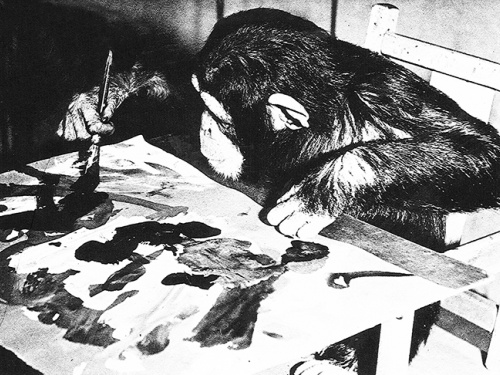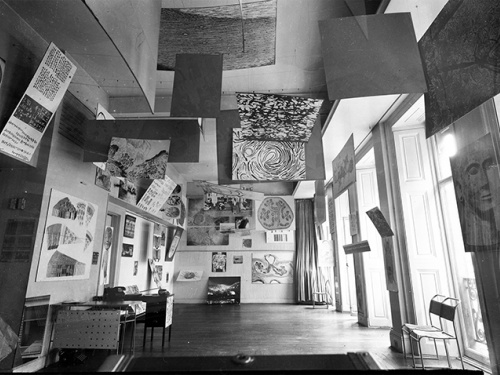Surrealism, Sex and Sadomasochism: The Early Characters of the ICA
Surrealist painter, zoologist and best-selling author Desmond Morris is known for an impressive list of accomplishments, including being director of the ICA in 1967. Now 88 years old, Morris met with artist and writer Melanie Coles in his Oxford studio to recount his times at the ICA, a place he describes as ‘the seat of rebellion’, home of the surrealists and 'playground' for the avant-garde.
This three-part edited transcript Chimpanzees, Controversy and Contemporary Art: A Conversation with Desmond Morris offers a unique personal insight into the ICA’s subversive origins, recalling first-hand encounters with the legendary characters who roamed the ICA from Herbert Read and Roland Penrose to Pablo Picasso, Francis Bacon, Henry Moore, Barbara Hepworth, Allen Ginsburg and Henri Cartier-Bresson.
Roland Penrose was an extraordinary character. He lived right through the avant-garde and was a major figure in keeping it going in this country. He organised the 1936 International Surrealist Exhibition which was the first major exhibition of modern art in London and then started the ICA with the writer Herbert Read. The impact that Penrose had was enormous and I don’t think he’s been given enough credit for it. What was so strange about him was that there were two Penroses.
One was the Penrose who was entertaining Princess Margaret at the Tate. The other was the true surrealist rebel who was responsible for the surrealist exhibition, The London Gallery and the ICA. These two Rolands both were real. Art critic George Melly wrote a savage attack against him when he accepted a knighthood saying, "I will never have anything to do with you again" because George was an out and out rebel. But what he couldn’t understand was that there were two perfectly genuine Roland Penroses. People have a ridiculous way of pigeonholing others and assuming that they can only be one thing.
There were two Dalis as well. There was the really talented, serious artist and then the silly fool. They were both Dali. His early work is the work of genius. It involved him sitting hour after hour after hour wearing his spectacles and with his magnifying glass, producing these intricate pictures with extraordinary imagery. Then there was the clown Dali who was playing the fool. When he was staying at a hotel in New York he used to have somebody ringing a bell before he would appear.
"People have a ridiculous way of pigeonholing others and assuming that they can only be one thing."
A friend of mine who was staying with him said he was permanently serious until a photographer arrived and then he said "Excuse me, I must go put on my critical paranoiac face." He disappeared and came back with his moustache up and his walking cane, making silly gestures and putting on a show. So these two Dalis were both genuine. His public clowning image was part of him, but people who didn’t like him thought that was it, so they thought his pictures were silly. Later Dali got kitschy, but the early Dali was brilliant.
I have always been two people myself. I am an objective scientist and then I go into my studio and my other hemisphere of my brain starts to work. I become an artist and am irrational in my surrealist work. I am two people, Dali was two people, Roland was two people. He cared desperately about artistic freedom. When I was director at the ICA for a year, one of the exhibiting artists was arrested by the police because he had cannabis in his pocket and Roland said to me, "They cannot prosecute him for this, he’s a serious artist and must be allowed to smoke cannabis if he wants to. You must go on behalf of the ICA and support him." So I had to go to court. I remember giving evidence and saying, "this artist may have had cannabis in his pocket but he is an important artist and is doing really original work." I defended him and somehow he got off. Roland was so excited by this.
"Cartier Bresson wouldn't go into his own exhibit or be interviewed. He was like a floating figure."
The Allen Ginsberg evening also stands out as an important memory from the time that I was director. I wasn’t too sure it was going to work because all I knew was that it was a poetry reading and I thought "hmmm." But by the end of the evening we all left feeling like we had an experience. It was hypnotic in the way he did it. I remember that very vividly. There were all kinds of moments I recall though.
I remember saying, "Who’s that man half hiding over in that corner?" and they said, "Oh, that’s Cartier-Bresson." I thought "Why is he hiding? He has an exhibition on here." He didn’t want anybody to see his face. I guess because as a photographer, if he became known as a character it would have ruined his tact. His secret was to sit quietly where nobody noticed and get the shot. He wouldn’t go into his own exhibit or be interviewed. He was like a floating figure.
All this excitement and these characters were due to Roland Penrose really. Roland was very clever. He never personally got involved in a scandal while others around him did. He was the really important figure, the key man in the development of modern art in Britain. He had a surrealist committee. I think nearly all the surrealists got expelled at some point because they were always breaking the rules. Dali got expelled twice. Max Ernst got expelled twice too. Matta got expelled. Henry Moore got expelled because he had no money and somebody offered him 600 quid to make a statue of the virgin and child for a church and he did it. It’s really just a mother and a child but since it was the ‘virgin and child’ they expelled him. They were very anti-religion. Again, Henry was two people because if you met him you would think you were talking to a Yorkshire farmer. You wouldn’t think this was Henry Moore - he was very down to earth.
"Dear Francis Bacon, I was very fond of him. His whole life was surreal."
Dear Francis Bacon, I was very fond of him. He was out and out but there was nothing orthodox about him. His whole life was surreal. The sad thing about him was that he was desperate to be a part of the surrealist movement. He considered himself a surrealist but he was rejected because they were violently anti-religious and Francis had done a lot of work with crucifixions. They assumed that these crucifixions indicated he was religious but it was nothing to do with religion. The crucified figures weren’t Christ, they were Francis. He was a masochist who had masochistic rituals in which he had himself tied up and beaten. Herbert Read just didn’t understand this.
Poor Francis got rejected. In those days homosexuality was illegal and he was sent to jail. He had to keep quiet about it. As for sado-masochism, that was even worse at the time. To be a sado-masochistic homosexual was as far beyond the pail as you could get. Roland should have understood because he was quite odd sexually. There is one wonderful moment where Peggy Guggenheim wrote that she didn’t like going to bed with him because she didn’t like having to spend all night handcuffed to the bed. When she wrote her biography she said to Roland, "Look I put in the business about your gold handcuffs in the book." He said, "Oh, you musn’t put that in." and she said "Why? You still want to keep it a secret?" and he said "No, no it’s just that they weren’t gold, they were ordinary police handcuffs."
"Peggy Guggenheim didn’t like going to bed with Roland Penrose because she didn’t like having to spend all night handcuffed to the bed."
What those people were doing at the time, jumping into bed with one another, was quite scandalous and they had to keep quiet about it. A lot of them had very strange sex lives. Sexually exotic is a better way to express it. There were very strict morals about sexual behaviour. I met all kinds of people at the ICA in those days.
Henry Moore had a very orthodox, straightforward private life. Francis had the wildest private life you could possibly imagine. Yet they were all great artists. In those days, people like Francis and Roland had to lead double lives. If the full story of their private lives had been known, prior to the 1960s they would have been in serious trouble. The 60s kind of released all that and the freedoms developed. The ICA has to be remembered as a place that was being avant-garde at a time when orthodoxy was still controlling society. That’s what made it such an important place. ■
This transcript is the second of a three-part series Chimpanzees, Controversy and Contemporary Art: A Conversation with Desmond Morris based on an interview by Melanie Coles with Desmond Morris at his studio in Oxford, UK, 2016, and edited by Melanie Coles and Maya Caspari.
2016 is the ICA's 70th Anniversary. To help celebrate our anniversary, we have put out a call to members for any further stories or archive material from the ICA’s illustrious past, in order to record the ICA’s incredible history. Any material should be shared with archives@ica.org.uk.
This article is posted in: Articles, Blog, Interviews, Members News
Tagged with: Desmond Morris, Melanie Coles, Surrealism, Chimpanzees Controversy and Contemporary Art: A Conversation with Desmond Morris, The Surrealists, Roland Penrose, Salvador Dali, Herbert Read, ICA History, Archive, From the Archive, Henry Moore, Francis Bacon, Archives, History of Art, Maya Caspari










